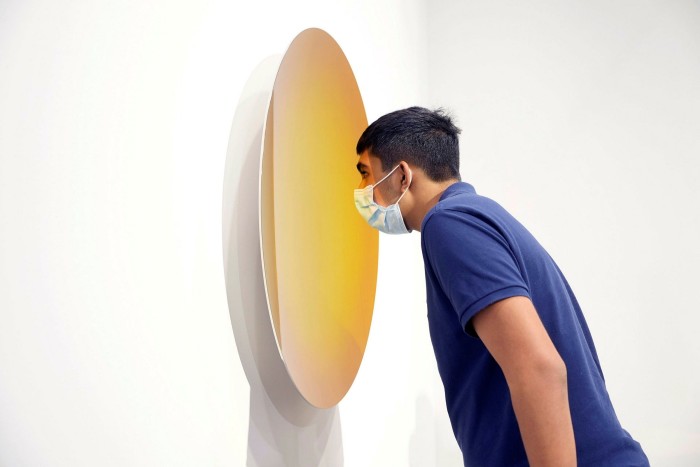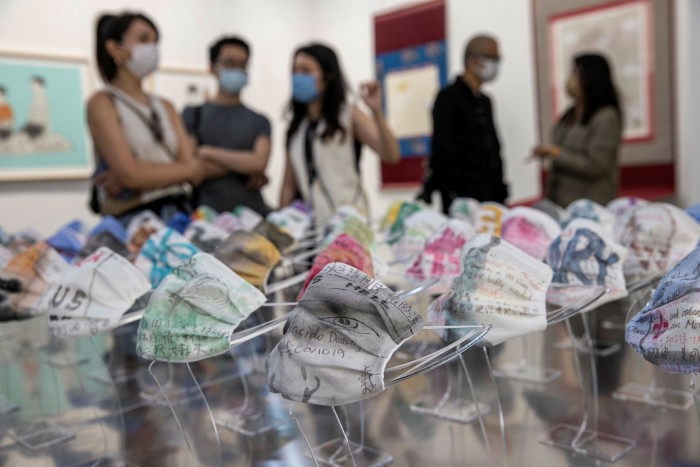[ad_1]
When pro-China figures in Hong Kong began asking questions over what type of art should be allowed at the city’s new M+ Museum of visual culture, it exposed a growing rift between artistic freedoms and state censorship in the territory.
These tensions, which emerged after the city’s introduction of a tough national security law last year, will be further tested when one the world’s biggest art fairs returns to Hong Kong on Friday. More than ever, the territory’s once freewheeling cultural community is being squeezed by Beijing, critics say.
“M+, Art Basel and many big international art names have opened galleries in Hong Kong, but that was all before this new national security law,†said Ai Weiwei, China’s best-known dissident artist, whose works were donated to the M+ gallery on Kowloon’s waterfront set to open this year.
“This is the last nail in this coffin,†he said. “They’re trying to stop this independent culture . . . [using] the national security law.â€
Organisers of the Art Basel fair, taking place at the Hong Kong Convention and Exhibition Centre, hope the creative expression on display can dodge the issues that have entangled the city.
“The government hasn’t asked us to do anything differently — except to do our show,†Adeline Ooi, Asia director for Art Basel, told the Financial Times, insisting she was committed to her “dream of making Hong Kong an international cultural hubâ€.
She accepted that the art fair’s return in the midst of a pandemic — and after Hong Kong had endured unprecedented protests and political turmoil — had prompted questions from the art world.
“Galleries were concerned, galleries from overseas [were] not fully understanding what’s going on,†she said, insisting these worries did not always reflect the reality on the ground.
Yet there is little doubt that the national security law introduced in June last year, which critics say criminalises dissent, has unleashed a severe crackdown across Hong Kong, with activists imprisoned, teachers sacked and parts of the media brought to heel.
Eunice Yung, a pro-Beijing lawmaker, has sought to broaden this to the art world by asking whether the works at M+, which includes 26 pieces from Ai Weiwei, breached the security law. This led Carrie Lam, the territory’s leader, to pledge that her officials would be “extra cautious†to ensure that all the exhibits were lawful.
Ai Weiwei said the museum would still show two of his works, “Still Life†and “Whitewashâ€, but that it had no plans to exhibit his “Study of Perspective: Tian’anmen†in which he gives the middle finger to the Beijing square that was the scene of the infamous 1989 student massacre.
Meanwhile, attacks on the arts have continued, with the pro-China Ta Kung Pao newspaper accusing the Hong Kong Arts Development Council of funding projects, films and theatre groups that could also contravene the law.
One cinema responded by cancelling the showing of a documentary about the siege at The Hong Kong Polytechnic University during the 2019 anti-government protests, where students attempted to escape a police blockade by abseiling down the school’s walls.
The fair comes as interest in art rises across the Greater China region that includes Hong Kong, despite the pandemic. Art sales across the region totalled $10bn in 2020.
Greater China last year overtook the US to become the world’s largest auction market, with a 36 per cent market share, according to the 2021 Art Basel and UBS Global Art Market Report.
Christie’s in March announced a record for the most expensive western artwork ever sold in Asia, when Jean-Michel Basquiat’s “Warrior†sold for HK$323m ($42m) in its Hong Kong saleroom.
“Many Hong Kong galleries are doubling down . . . not only building for gallery space but also studios and residencies for their artists,†Ooi said of the boom.
The development of M+ and the new West Kowloon cultural district is part of a regeneration pushed by powerful figures in Hong Kong’s establishment.
Bernard Chan, who advises Lam, has voiced frustration that the attacks on the arts are endangering an important industry
“Supervising and even censoring the art shown in our museums and galleries . . . put us at risk of losing our global reputation,†he wrote in the South China Morning Post. “We would be imperilling an economic sector in which we have invested years of effort and billions of dollars,†he added.
For many of those exhibiting at Art Basel, the clampdown has left an imprint. Visual artist Kong Chun Hei will make visitors to his exhibition stall cross a speed bump on the ground made up of kitchen scales so they can be “measuredâ€, as part on an examination into the proliferation of government surveillance.
Kwok Mang-ho, a 73-year-old artist who performed in Tiananmen Square just a year after the massacre, said that while he did not feel censored, artists in Hong Kong today were sometimes required to “control themselvesâ€.
“I did many crazy things when I was young . . . [Now] I do the right thing at the right time — that’s the survival technique. I try to control myself, just like at Art Basel. I walk peacefully, I don’t throw firebombs,†he said.
[ad_2]
Source link








